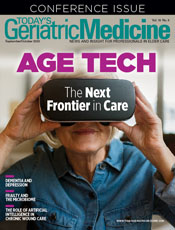
September/October 2023
Bone Health: The Bone/Brain Connection Are bone health and brain health linked? One study suggests they could be. Knowledge about the human body’s systemic relationships increasingly is helping those who care for older adults make better choices as they age. Recent research showing a connection between bone health and brain health is one example. A study published in Neurology, the medical journal of the American Academy of Neurology, found that people who have low bone density might be at a 42% higher risk for developing dementia. According to study author Mohammad Arfan Ikram, MD, PhD, of the Erasmus University Medical Center in Rotterdam, Netherlands, this study did not prove that low bone density causes dementia, but it shows an association—something important for practitioners to note. “What we see is that most people with dementia often also suffer from other diseases, a concept called multimorbidity,” Ikram explains. “We already know this for the link with dementia of heart disease, stroke, lung disease, kidney disease, and liver disease. In this study, we studied and showed the link between bone health and dementia. This doesn’t necessarily suggest that bone health causes dementia; instead, it shows that during the preclinical phase of dementia—that is, the years before clinical diagnosis of dementia—bone health too shows deterioration.” With the World Health Organization reporting that more than 55 million people worldwide are living with dementia, it’s important not to overlook other potential conditions these individuals might be experiencing. It’s already known that bone health commonly deteriorates as one ages. According to the National Osteoporosis Foundation, approximately 10 million Americans have osteoporosis, with another 44 million experiencing low bone density, which places them at higher risk for osteoporosis. The prevalence of these conditions makes it important to consider early warning signs. Typically, the earliest warning signs of dementia include memory problems, confusion, and reduced concentration. Aches, pains, and fractures are typically early signs of osteoporosis. A Closer Look at the Study Adjustments related to age, sex, education, other illnesses and medication use, and family history of dementia were made, leading researchers to determine that within 10 years, people with the lowest total bone density were 42% more likely to develop dementia than were people in the highest bone density group. A limitation of the study is that participants were primarily of European descent and aged 70 or older at the start of the study. These findings may differ by race or ethnicity and in younger age groups. “The main message to come from this is twofold,” Ikram explains. “First, we should recognize that in one individual, multiple organs can be affected by the aging process, and these may be linked. Second, in persons with early or preclinical dementia, we should be mindful of the fact that bone health has probably also deteriorated. This should be taken into account how we organize care around a person with dementia. For instance, institutionalization and loss of independence in persons with dementia is often equally due to their loss of mobility as due to decline in memory performance.” Ikram says maintaining bone health in older adults could help keep these individuals mobile and, therefore, physically independent for a longer period of time. Understanding the Link “It’s possible that bone loss may occur already in the earliest phases of dementia, years before any clinical symptoms manifest themselves,” Ikram continues. “If that were the case, bone loss could be an indicator of risk for dementia and people with bone loss could be targeted for screening and improved care.” Ikram adds that his current study does not provide evidence of whether any form of screening is helpful. While the reasons for any potential link are not understood, Ikram has surmised several possible explanations. One is that bone health and brain health share risk factors. “For instance, smoking is a risk factor,” he says. “We know that smoking is bad for your bones as well as your brain. Other such shared factors could include lifestyle, physical activity, diet, environmental factors, and also genetic predisposition.” Reverse causality is another possible explanation, he says. In other words, the “chicken or the egg” scenario. “Persons in early stages of dementia may already show deterioration in their daily functioning, which could include taking less care of themselves,” Ikram continues. “This would then express itself in poorer bone health. As such, it is the underlying dementia process that leads to the poor bone health, not the other way around in this surmised scenario.” Even so, given the link between risk factors for deteriorating brain health and bone health, it always makes sense to urge patients to quit smoking and increase their physical activity. There’s not a downside to these types of recommendations; they can only help. Looking to the Future Ikram says for many diseases in older adults, preventable factors are involved. This presents an opportunity for providers and caregivers to get involved at an earlier stage. “That means there is a huge public health burden that could be at least partially preventable,” he concludes. “We should all act on that urgently.” — Lindsey Getz is an award-winning freelance writer in Royersford, Pennsylvania. |
